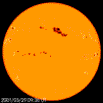 |
Plot Sunspots
since 1755
This site allows you to plot 11 years worth
of sunspot numbers centered on any date between 1755 and the present.
Great for retrieving sunspot data!
|
 |
The Spinning Sun
An activity for you to determine the solar rotation
rate based upon the movement of sunspots.
|
 |
The
Sunspot Cycle
Daily observations and counts of sunspots were
started at the Zurich Observatory in 1749 and, with the help of other
observatories, continuous observations have been obtained since 1849.
Monthly averages of the sunspot numbers show that the number of sunspots
visible on the Sun waxes and wanes with an approximate 11-year cycle.
Visit this site to find graphs and charts of sunspot activity, including
current ones updated monthly. Note, however, that the "Sunspot Number"
referred to in these graphs is not a count of sunspots, but rather a number
adjusted to take into account the number of groups visible, the number
of individual spots visible, and differences between observers. The next
reference describes how the number is determined. By David H. Hathaway
of the NASA/Marshall Space Flight Center.
|
 |
What is the
Current Sunspot Number?
The abundance of sunspots on the Sun varies
on timescales from a few hours to many years. Historically, an index called
the 'sunspot number' has been used to quantify the abundance of spots.
The index is still in wide use today. This site explains how the "sunspot
number" is computed.
|
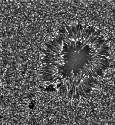 |
Want to track solar activity?
The Paderborn Public Observatory in Germany
hosts a non-profit amateurs club whose main activity is solar observation.
The club has established the INTER-SOL Programme (ISP) which is an addition
to, but different from, the usual method of monitoring and classifying
sunspots. About 50 stations, amateurs as well as professionals throughout
the world contribute their data to INTER-SOL.
|
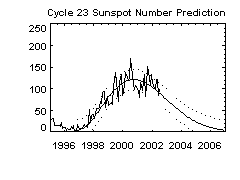 |
Sunspot
Cycle Predictions
Several techniques are used to predict the amplitude
of a sunspot cycle during the time before sunspot minimum. Relationships
have been found between the size of the next cycle maximum and the length
of the previous cycle, as well as the level of activity at sunspot minimum
and the size of the previous cycle. Among the most reliable techniques
are those that use the measurements of changes in the Earth's magnetic
field at, and before, sunspot minimum. These changes in the Earth's magnetic
field are known to be caused by solar storms but the precise connections
between them and future solar activity levels is still uncertain. Marshall
Space Flight Center
|
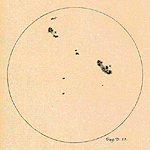 |
Galileo's View of Sunspots
Galileo was not the first to observe sunspots
(the Chinese earned that distinction thousands of years before), but Galileo
was the first to study sunspots and their movements through a telescope.
He carefully sketched what he saw. Some refuted his drawings, claiming
the black spots were unknown planets crossing the disk. But Galileo was
able to prove the spots were on the Sun (see Galileo's
Proof and that of another scientist Wilsons
Proof).
|
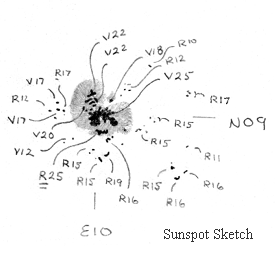 |
Daily
Sunspot Sketchs at Mt. Wilson |

|
Take
the Sunspot Quiz!
These sets of questions
test your knowledge of sunspots.
|

